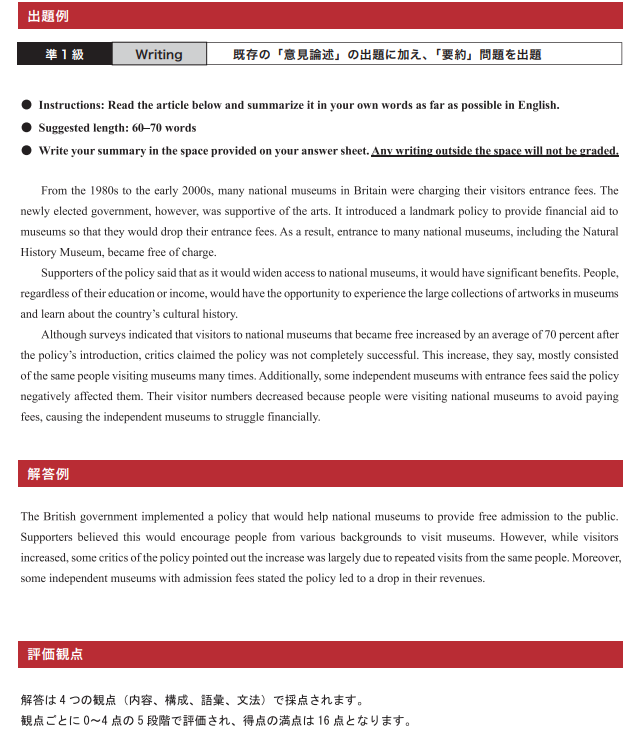EIKEN Grade Pre1 Writing Added ‘Summary’ task to existing ‘Opinion’ task.
Sample Question and Answer
● Instructions: Read the article below and summarize it in your own words as far as possible in English.
● Suggested length : 60–70 words
● Write your summary in the space provided on your answer sheet. Any writing outside the space will not be graded.
Evaluation Criteria
Answers will be graded on four aspects: content, structure, vocabulary, and grammar.
Each perspective is evaluated on a 5-point scale from 0 to 4 points, with a maximum score of 16 points.
「 5 Tips for Answering Summary Questions」
① Identifying the Main Argument ⇒ After reading the entire paper, the author’s main argument is identified. The summary revolves around this main argument.
② Abstracting Specific Terms ⇒ Specific terms and proper nouns are paraphrased into more general or abstract expressions. For example, specific names like “Lake X” or “River Y” are changed to words like “water source” and abstracted.
③ Constructing Logical Structure ⇒ Care is taken to establish a logical structure, including causal relationships, to maintain the same logical flow as the original text. The summary simplifies the presentation of the main argument and the flow of the original text. Paragraph One Summary → Paragraph Two Summary → Paragraph Three Summary
④ Eliminating Redundancy ⇒ Redundant information and repetitions are removed, focusing on essential information. By consolidating repeated sentences or similar words into more general terms, the summary is made concise.
⑤ Confirming Coherence ⇒ Checking if the summary conveys the author’s main argument without requiring prior knowledge.
Lesson 1 (181 words)
In recent years, there has been a notable increase in the integration of technology in education, particularly in universities. This shift has been driven by the growing recognition of the diverse benefits that technology can bring to the learning process. For instance, many universities now offer online courses, allowing students to learn remotely and at their own pace. This flexibility is especially beneficial for those who have other commitments, such as work or family.
Furthermore, the use of technology has enabled the personalization of education. Educational software and online platforms can adapt to individual learning styles and paces, providing a more tailored educational experience. This approach has shown to improve student engagement and comprehension, as they can learn in a manner that suits them best.
However, this transition has not been without its challenges. Critics point out the digital divide, where students from lower socioeconomic backgrounds may not have access to the necessary technology, thus widening the gap in educational equality. Additionally, there’s the concern of over-reliance on technology, which might affect the development of traditional learning and critical thinking skills.
Sample Answer (57 words):
Universities have increasingly incorporated technology into their educational systems, offering benefits like remote learning and personalized education. This shift has improved flexibility and engagement, catering to diverse student needs. However, critics highlight issues such as the digital divide, disadvantaging less privileged students, and the potential over-reliance on technology, which might impede the development of traditional academic skills.
================================================
Lesson 2 (187 words )
The integration of artificial intelligence (AI) in healthcare is revolutionizing medical diagnosis and treatment. AI systems, with their ability to process vast amounts of data, are aiding in the early detection of diseases, personalized treatment plans, and the development of new drugs.
AI technology in medical imaging enables more accurate diagnoses. Machine learning algorithms can analyze scans faster and more accurately than humans, identifying subtle patterns that may indicate early stages of diseases like cancer. This leads to timely and more effective treatments.
In personalized medicine, AI analyzes patient data to tailor treatments to individual needs. This approach is particularly effective in managing chronic diseases where treatment responses vary widely among patients. AI also speeds up drug development by simulating clinical trials and predicting the effectiveness of compounds, reducing the time and cost of bringing new drugs to market.
However, challenges exist, including concerns about data privacy and the potential loss of human elements in patient care. Ensuring the ethical use of AI and maintaining patient trust are paramount. Additionally, the high cost of AI technology and the need for specialized skills pose barriers to widespread adoption.
Sample Answer (79 words):
Artificial intelligence (AI) is transforming healthcare by improving disease detection, creating personalized treatment plans, and accelerating drug development. It enables more precise medical imaging diagnoses and customizes treatments for chronic diseases, enhancing their effectiveness. AI also reduces the time and cost of new drug introductions by predicting compound effectiveness. Despite its benefits, challenges like data privacy concerns, the risk of diminishing human interaction in care, ethical issues, and the high costs and skill requirements for AI implementation remain significant.
======================================================
Lesson 3 (182 words )
The impact of climate change on global agricultural practices is a pressing concern. Rising temperatures, unpredictable weather patterns, and increased incidence of droughts and floods are adversely affecting crop yields. These changes challenge traditional farming methods and threaten food security worldwide. In response, farmers are adopting more resilient agricultural practices, such as drought-resistant crops, improved irrigation techniques, and alternative farming methods like vertical farming.
Simultaneously, there is a growing emphasis on sustainable agriculture to reduce the environmental footprint of farming. This includes practices like organic farming, reduced use of chemical fertilizers and pesticides, and integrated pest management. These methods aim to maintain soil health, conserve water, and preserve biodiversity, ensuring long-term agricultural productivity.
However, transitioning to sustainable and resilient agricultural practices presents challenges. It requires significant investment in research and development, as well as in educating farmers about new techniques. Furthermore, small-scale farmers in developing countries often lack the resources and access to technology needed for such a transition. Addressing these disparities is crucial for global efforts to combat the impacts of climate change on agriculture and ensure food security for all.
Sample Answer (65 words):
Climate change significantly affects agriculture, necessitating shifts to more resilient and sustainable practices. Farmers are adopting strategies like drought-resistant crops and sustainable methods to combat adverse effects and reduce environmental impact. However, transitioning poses challenges, particularly for small-scale farmers in developing countries, due to resource and technology constraints. Overcoming these hurdles is essential for global food security and adapting agricultural practices to the changing climate.
=====================================================
Lesson 4 (230 words )
The increasing focus on mental health in the workplace marks a significant shift in corporate culture. Businesses are recognizing the importance of mental well-being for employee productivity and overall organizational success. This recognition has led to the implementation of various mental health initiatives, such as employee assistance programs, mental health days, and workplace wellness activities. These measures aim not only to support employees dealing with mental health issues but also to foster a more inclusive and supportive work environment.
One key aspect of this shift is the destigmatization of mental health in the workplace. Encouraging open conversations about mental health challenges and providing access to professional support services are vital steps in creating a stigma-free environment. This openness helps employees seek the help they need without fear of judgment or professional repercussions. Additionally, promoting work-life balance through flexible work arrangements and manageable workloads is crucial in preventing burnout and stress-related illnesses.
However, effectively addressing mental health in the workplace is not without challenges. It requires a commitment from top management to prioritize mental health as a key aspect of organizational policy. There is also the challenge of ensuring that mental health initiatives are accessible to all employees and that they cater to diverse needs. Furthermore, continuous efforts are needed to maintain and improve these initiatives, adapting them to changing workplace dynamics and employee feedback.
Sample Answer (69 words):
The growing emphasis on mental health in the workplace reflects a shift in corporate culture towards prioritizing employee well-being. Initiatives include employee assistance programs and wellness activities, aiming to destigmatize mental health issues and promote work-life balance. Successfully implementing these measures requires management commitment and adaptation to diverse employee needs. Ongoing refinement based on employee feedback is essential to maintain effective and inclusive mental health support in the workplace.
=========================================================
Lesson 5 (190 words )
The integration of artificial intelligence (AI) into various sectors is revolutionizing traditional practices, especially in the field of education. AI’s presence in classrooms is reshaping teaching methods and enhancing student learning experiences. For instance, AI-driven personalized learning platforms are providing students with tailored educational content, adapting to individual learning styles and pace. This innovation is instrumental in facilitating a more effective and engaging learning environment.
Another significant application of AI in education is its role in administrative tasks. AI systems are increasingly being used for tasks like grading and attendance tracking, freeing up teachers’ time to focus more on teaching and student interaction. Moreover, AI is enabling the analysis of educational data to identify trends and improve teaching strategies, thus contributing to a more efficient educational system.
However, the adoption of AI in education also raises concerns. One major issue is the potential decrease in human interaction, which is vital for student development. Additionally, there are worries about data privacy and the digital divide, which could lead to inequalities in educational opportunities. Balancing the benefits of AI with these challenges is crucial for its successful integration into the education system.
Sample Answer (64 words):
Artificial intelligence is significantly transforming education, offering customized learning experiences and aiding in administrative tasks, thereby enhancing teaching efficiency. Personalized learning platforms and data analysis improve student engagement and educational strategies. However, this technological integration faces challenges, including reduced human interaction, data privacy concerns, and potential educational inequalities due to the digital divide. Addressing these issues is vital for AI’s effective use in education.
============================================================
Lesson 6 (193 words )
The rise of telehealth services has been one of the most significant developments in the healthcare industry in recent years. Telehealth, the remote delivery of healthcare services and clinical information using telecommunications technology, has become a crucial tool, particularly during the COVID-19 pandemic. It has enabled patients to access medical care without the risks associated with in-person visits, such as exposure to the virus.
One of the primary benefits of telehealth is its ability to provide healthcare access to people in remote or underserved areas. Patients who previously had to travel long distances for medical consultations can now receive care from the comfort of their homes. Additionally, telehealth offers convenience for those with mobility issues or chronic illnesses, for whom regular travel to healthcare facilities is challenging.
However, telehealth also faces significant challenges. The lack of personal interaction between healthcare providers and patients can impact the quality of diagnosis and treatment. Moreover, the effectiveness of telehealth is limited by the digital divide, as not all patients have access to the necessary technology or stable internet connections. This disparity highlights the need for broader infrastructure development to make telehealth services more universally accessible.
Sample Answer (67 words):
Telehealth services, providing remote medical care, have emerged as a vital healthcare tool, especially during the pandemic, offering safer access to care and benefiting those in remote or underserved areas. While telehealth brings convenience for patients with mobility issues, it faces challenges like reduced patient-provider interaction and the digital divide, affecting diagnosis quality and access for those without technology or internet, underlining the need for improved infrastructure.
=======================================================
Lesson 7 (188 words )
The ongoing debate regarding the impact of social media on youth mental health is a topic of significant concern. Social media platforms, while providing a space for connectivity and self-expression, also expose young users to various stressors. These include cyberbullying, social comparison, and the pressure to maintain an idealized online persona. The constant exposure to such environments is contributing to increased rates of anxiety and depression among young individuals.
However, social media also has positive aspects. It offers youths opportunities for social engagement and community building, particularly for those who may feel isolated in their physical environments. Platforms can serve as outlets for creative expression and sources of informational and educational content. This dual nature of social media makes it a complex but integral part of modern youth culture.
Addressing the challenges posed by social media requires a multifaceted approach. Education about digital literacy and responsible online behavior is crucial. Parents, educators, and mental health professionals need to work together to provide support and guidance. Additionally, there is a growing call for social media companies to implement stronger measures to protect young users from harmful content and interactions.
Sample Answer (72 words):
Social media’s role in youth mental health is a nuanced issue, presenting both challenges and benefits. While it can lead to anxiety and depression due to factors like cyberbullying and social pressure, it also offers valuable opportunities for social connection, creativity, and learning. Addressing its negative impact requires digital literacy education, collaborative support from adults, and enhanced protective measures from social media platforms to ensure a safer online environment for young users.
========================================================
Lesson 8 (202 words )
The integration of artificial intelligence (AI) in education is revolutionizing the way teaching and learning occur in classrooms worldwide. AI’s ability to offer personalized learning experiences is perhaps its most notable benefit. Utilizing AI algorithms, educational content can be tailored to the individual learning styles and needs of students, enhancing their engagement and understanding. This personalization allows for a more dynamic and effective educational experience.
Beyond personalized learning, AI is significantly impacting administrative aspects of education. Automated systems are increasingly being used for tasks such as grading, attendance tracking, and identifying students who require additional support. This automation not only saves time but also allows educators to dedicate more effort to teaching and interacting with students, thereby enriching the learning environment.
However, the adoption of AI in education also brings certain challenges. Data privacy concerns are paramount, as sensitive student information is handled by AI systems. Additionally, the digital divide poses a significant issue, with students lacking access to technology being potentially disadvantaged. Moreover, an over-reliance on AI could lead to diminished human interaction, an essential element in education. Thus, while AI holds great promise for enhancing education, it is crucial to address these challenges to ensure its positive and equitable implementation.
Sample Answer (62 words):
Artificial intelligence is transforming education by providing personalized learning and streamlining administrative tasks. While AI tailors content to individual students’ needs, enhancing their engagement, it also aids educators in administrative duties, allowing more focus on teaching. However, challenges such as data privacy, the digital divide, and reduced human interaction need addressing to ensure AI’s beneficial and equitable integration into the educational system.
==========================================================
Lesson 9 (194 words )
The growing influence of social media on political discourse is a phenomenon that has reshaped modern politics. Social media platforms have become prominent spaces for political discussion, debate, and the dissemination of information. This digital environment allows for the rapid spread of political messages, enabling politicians and activists to reach a broader audience more efficiently than traditional media channels.
One significant impact of social media in politics is the increased engagement of younger demographics in political processes. Platforms like Twitter and Facebook have become tools for political mobilization, awareness, and activism, particularly among the youth. These platforms facilitate the sharing of political content, encourage discourse, and can even influence public opinion and voting behavior.
However, the use of social media in politics is not without its challenges. The spread of misinformation and fake news on these platforms has become a major concern. The anonymity and lack of regulation on social media can lead to the dissemination of unverified information, which can skew public perception and influence political outcomes. Additionally, the echo chamber effect, where users are exposed primarily to views that align with their own, can polarize public opinion and hinder constructive political discourse.
Sample Answer (68 words):
Social media’s role in shaping political discourse includes broadening political engagement, particularly among young people, and serving as a platform for information dissemination and activism. However, it also presents challenges like the spread of misinformation and the echo chamber effect, which can polarize opinions and affect political outcomes. These issues highlight the need for caution and critical thinking in consuming and sharing political content on social media platforms.
=======================================================
Lesson 10 (197 words )
The advent of 5G technology is set to revolutionize the world of telecommunications and beyond, heralding a new era of ultra-fast internet speeds and connectivity. 5G, the fifth-generation technology standard for broadband cellular networks, is not just an upgrade in speed; it brings capabilities that could transform various industries. It promises to significantly enhance mobile broadband services and enable technologies like the Internet of Things (IoT) to flourish.
One of the key benefits of 5G is its potential to dramatically improve wireless networks’ capacity and efficiency. This enhancement will not only provide faster internet access for smartphones and other devices but also allow for the connection of numerous devices simultaneously without lag. This is crucial for the development of smart cities and autonomous vehicles, which require constant and reliable connectivity to function effectively.
However, the rollout of 5G technology faces several challenges. There are concerns about the infrastructure investment required for its widespread adoption. Additionally, there are ongoing debates about the potential health risks associated with increased electromagnetic radiation. Moreover, ensuring security in an increasingly connected world remains a critical issue that needs to be addressed as 5G technology becomes more prevalent.
Sample Answer (68 words):
5G technology, with its ultra-fast speeds and enhanced connectivity, is poised to transform telecommunications and various industries. It will improve network capacity, enabling advancements in smart cities and autonomous vehicles. However, challenges include the substantial infrastructure investment needed, health concerns related to electromagnetic radiation, and security issues in a more connected world. Addressing these concerns is crucial for the successful and safe implementation of 5G technology.
====================================================
Lesson 11 (181 words )
The integration of technology in education, particularly the use of digital devices like tablets and laptops in classrooms, has been a transformative trend. This technological shift is not just a matter of replacing textbooks with screens; it’s about enhancing the learning experience. Digital tools offer an interactive and engaging way of learning through educational apps, online resources, and multimedia content. These technologies make information more accessible and cater to different learning styles.
However, the reliance on digital devices in education also brings challenges. One major concern is the digital divide – the disparity in access to technology between students from different socio-economic backgrounds. Students without access to reliable internet or modern devices may fall behind in their education. This gap poses a significant challenge to ensuring equal educational opportunities for all.
Furthermore, the overuse of screens and technology in education raises concerns about students’ health and social skills. Prolonged screen time can lead to issues like eye strain and reduced physical activity. There’s also the fear that excessive reliance on digital communication could hinder the development of face-to-face social skills in students.
Sample Answer (65 words):
The use of digital devices in education enhances learning through interactive and diverse resources but raises concerns like the digital divide and health implications. Access to technology varies, potentially widening educational disparities. Additionally, prolonged screen time might impact physical health and social skills development. Addressing these issues is crucial for the effective and equitable integration of technology in educational settings, ensuring benefits without detrimental effects.
=======================================================
Lesson 12 (180 words )
The rapid advancement of biotechnology is reshaping the medical landscape, offering groundbreaking opportunities in treatment and diagnosis. Biotechnology, which includes genetic engineering and molecular biology, is leading to the development of personalized medicine. This approach tailors treatments to individual genetic profiles, increasing the effectiveness of therapies and reducing side effects. Personalized medicine represents a significant shift from the traditional one-size-fits-all approach in healthcare.
Another notable application of biotechnology is in the field of regenerative medicine. Techniques like stem cell therapy and tissue engineering are being developed to repair or replace damaged organs and tissues. This has the potential to treat a range of conditions, from spinal cord injuries to heart disease, fundamentally changing how these ailments are managed.
However, biotechnology’s rapid growth raises ethical and safety concerns. Issues like gene editing and cloning have sparked debates about the moral implications of altering human biology. There are also concerns about the accessibility of these advanced treatments, which could exacerbate health disparities if only available to a privileged few. Ensuring ethical practices and equitable access is crucial as biotechnology continues to evolve.
Sample Answer (68 words):
Biotechnology is revolutionizing medicine with personalized treatments and regenerative therapies, including stem cell therapy and tissue engineering. This advancement offers tailored therapies based on genetic profiles and new possibilities in treating severe conditions. However, it also raises ethical concerns regarding gene editing and health disparities in access to advanced treatments. Addressing these challenges is essential to ensure ethical practices and equitable access in the evolving field of biotechnology.
====================================================
Lesson 13 (197 words )
The ongoing digital transformation in the business world has been significantly accelerated by the COVID-19 pandemic, leading to a rapid shift towards remote work and digital operations. This shift has necessitated a reevaluation of traditional business models, as companies adapt to a more digital-centric approach. The transition to remote work, enabled by digital technologies, has challenged conventional notions of workplace and workforce management.
One of the key impacts of this digital shift is the change in consumer behavior. With increased online activity, businesses are focusing more on digital marketing strategies and e-commerce platforms. This change requires businesses to be more agile and responsive to the digital marketplace’s dynamics. Companies are leveraging data analytics and AI to better understand and predict consumer trends, enhancing customer engagement and personalizing the shopping experience.
However, the digital transformation journey is not without challenges. Cybersecurity risks have escalated with the increased reliance on digital platforms, necessitating robust security measures. Additionally, the digital divide, the gap between those with and without access to digital technology and the internet, poses a challenge for both businesses and consumers. Bridging this divide is essential for inclusive growth and the sustainable success of digital business models.
Sample Answer (68 words):
The digital transformation in business, accelerated by the COVID-19 pandemic, has led to a shift towards remote work and digital operations, altering traditional business models and consumer behavior. Businesses are increasingly focusing on digital marketing and e-commerce, utilizing data analytics and AI. However, challenges like heightened cybersecurity risks and the digital divide need addressing to ensure the sustainable success and inclusivity of these evolving digital business strategies.
=====================================================
Lesson 14 (212 words )
The increasing focus on sustainable tourism is reshaping the travel industry, emphasizing the need for environmentally friendly and culturally respectful travel practices. This shift is driven by a growing awareness of the negative impacts traditional tourism can have on natural environments and local communities. Sustainable tourism aims to minimize these impacts while providing meaningful experiences for travelers and benefits for host communities.
One of the key components of sustainable tourism is the promotion of eco-friendly practices. This includes supporting accommodations and tours that use renewable energy sources, reduce waste, and conserve natural resources. Travelers are encouraged to engage in activities that have a low environmental impact, such as hiking, biking, and wildlife watching, which also offer immersive experiences in nature.
Another important aspect is cultural sensitivity and community involvement. Sustainable tourism advocates for respecting local cultures and traditions, ensuring that tourism activities do not disrupt or exploit local communities. It also promotes economic benefits for local populations by supporting local businesses and crafts.
However, the implementation of sustainable tourism practices faces challenges. Convincing travelers and tourism operators to adopt more sustainable habits requires education and awareness. Additionally, balancing the economic benefits of tourism with environmental conservation and cultural preservation is a complex task that requires ongoing effort and commitment from all stakeholders.
Sample Answer (67 words):
Sustainable tourism focuses on environmentally friendly and culturally respectful travel, aiming to reduce the negative impacts of traditional tourism. It encourages eco-friendly practices and activities with low environmental impact while advocating for cultural sensitivity and community involvement. However, promoting sustainable habits among travelers and operators and balancing economic, environmental, and cultural aspects are significant challenges, requiring education, awareness, and commitment from all involved in the tourism industry.
======================================================
Lesson 15 (203 words )
The growing trend towards urbanization has led to a surge in smart city initiatives, aiming to enhance urban life through technology. Smart cities use digital technology to improve city services, infrastructure, and quality of life. These technologies include IoT (Internet of Things) devices, advanced data analytics, and AI-driven systems, which work together to create more efficient and sustainable urban environments.
One of the key features of smart cities is the optimization of transportation systems. Through the use of sensors and data analytics, traffic flow can be better managed, reducing congestion and travel time. Public transportation systems also benefit from smart technologies, with real-time updates and improved scheduling. Another significant area is energy management. Smart cities utilize renewable energy sources and implement energy-saving technologies to reduce their carbon footprint and promote sustainability.
However, the development of smart cities is not without challenges. The primary concern is the privacy and security of the vast amount of data collected and used by these technologies. There is also the issue of the digital divide; not all residents may have equal access to the benefits of smart city technologies, potentially leading to inequalities. Addressing these concerns is crucial for the successful implementation and acceptance of smart city initiatives.
Sample Answer (67 words):
Smart cities, leveraging digital technology, aim to enhance urban life by optimizing transportation, managing energy efficiently, and improving city services. They utilize IoT devices, data analytics, and AI to create sustainable and efficient environments. However, challenges like data privacy, security, and the digital divide need addressing to ensure equitable benefits and acceptance of smart city technologies, making their development a complex yet vital task for urban advancement.
======================================================
Lesson 16 (193 words )
The burgeoning field of renewable energy technology is making significant strides, particularly in solar and wind energy, signaling a pivotal shift in global energy sources. Solar energy advancements have led to more efficient and cost-effective solar panels, making solar power increasingly viable for both residential and commercial use. This growth is crucial in the global effort to reduce reliance on fossil fuels and mitigate climate change impacts.
Wind energy, another renewable source, is also experiencing rapid development. Modern wind turbines are becoming more efficient and powerful, capable of generating significant amounts of clean energy. This progress is essential for diversifying energy sources and improving energy security. Offshore wind farms, in particular, are expanding, harnessing the power of ocean winds to provide a steady and abundant energy supply.
However, the transition to renewable energy is not without challenges. The variability of sources like solar and wind requires effective energy storage solutions to ensure a stable supply. Additionally, the environmental impact of manufacturing and disposing of renewable energy infrastructure, such as wind turbine blades and solar panels, poses concerns. Addressing these issues is crucial for achieving a sustainable and effective transition to renewable energy sources.
Sample Answer (66 words):
Renewable energy technology, particularly in solar and wind energy, is advancing, reducing dependence on fossil fuels and aiding climate change mitigation. Solar panels are becoming more efficient and cost-effective, while wind turbines are generating more clean energy. However, challenges include managing the variability of these energy sources and addressing the environmental impact of renewable infrastructure. Effective solutions are vital for a sustainable transition to renewable energy.
=========================================================
Lesson 17 (206 words )
The rapid advancement of artificial intelligence (AI) and its integration into healthcare is revolutionizing medical diagnostics and treatment. AI’s ability to process vast amounts of medical data with precision and speed is enabling more accurate diagnoses and personalized treatment plans. This technological evolution is particularly evident in areas like oncology and neurology, where AI algorithms assist in detecting diseases at earlier stages than traditional methods.
Another significant impact of AI in healthcare is the enhancement of patient care. AI-powered tools are being used to monitor patient health in real-time, predict potential health risks, and provide targeted care recommendations. This proactive approach to healthcare not only improves patient outcomes but also reduces the burden on healthcare systems. Additionally, AI is facilitating the development of new drugs and medical therapies by analyzing complex biochemical interactions at a pace far exceeding human capabilities.
However, the integration of AI into healthcare also presents challenges. Ethical concerns regarding patient privacy and data security are paramount. The reliance on AI for medical decision-making raises questions about the accuracy of AI systems and the potential loss of human oversight in critical healthcare decisions. Addressing these concerns is crucial for the responsible and effective use of AI in advancing medical science and patient care.
Sample Answer (64 words):
Artificial intelligence is transforming healthcare by enhancing diagnostics, personalizing treatments, and improving patient care. It assists in early disease detection and develops new medical therapies. However, integrating AI into healthcare raises ethical concerns about data privacy and the accuracy of AI decision-making. Addressing these challenges is essential for ensuring AI’s responsible use in healthcare, maintaining human oversight, and advancing medical science effectively and ethically.
==========================================================
Lesson 18 (188 words )
In the heart of Silicon Valley, a groundbreaking initiative has been launched to integrate artificial intelligence (AI) into the public education system. This ambitious project, spearheaded by leading tech companies and educational institutions, aims to revolutionize the way students learn and teachers teach. The program introduces AI tutors and personalized learning plans in schools, tailored to each student’s unique learning style and pace.
The initiative has garnered widespread support from educators and parents alike. Advocates argue that AI technology will enhance the learning experience, making education more interactive and engaging. It allows for a more individualized approach, addressing the specific needs and strengths of each student. Furthermore, AI tutors are available 24/7, providing constant support and feedback, something that overworked teachers often struggle to offer.
However, the introduction of AI in schools has sparked debate. Critics raise concerns about the over-reliance on technology in education, fearing it may diminish the importance of human interaction in the learning process. There are also worries about data privacy and the potential biases in AI algorithms. Despite these concerns, the program continues to expand, aiming to establish a new standard in educational
Sample Answer (69 words):
Silicon Valley has introduced an innovative program to incorporate artificial intelligence into public schools, offering AI tutors and personalized learning plans. This initiative is praised for providing tailored and constant educational support, enhancing student engagement. Nevertheless, there are concerns about excessive dependency on technology, potential loss of human interaction in learning, data privacy, and inherent biases in AI, leading to a mixed response to this technological integration in education.
======================================================
Lesson 19 (205 words )
The city of Copenhagen has recently embarked on an ambitious environmental project: transforming its urban landscape into a haven for wildlife. The project involves creating a network of green spaces across the city, connecting parks, gardens, and other natural areas. This initiative aims to boost biodiversity by providing habitats for various species, particularly pollinators like bees and butterflies, which are essential for ecosystem health.
One of the key elements of this project is the introduction of wildflower meadows in public parks and along city streets. These meadows not only beautify the urban environment but also serve as vital food sources and breeding grounds for insects. Additionally, Copenhagen is installing bird and bat boxes to encourage these species to thrive within the city limits. The local government is also encouraging residents to participate by creating wildlife-friendly spaces in their own gardens.
Despite its benefits, the project faces challenges. Some citizens express concerns about increased maintenance costs and potential issues with wildlife interactions. However, city officials and environmentalists emphasize the long-term ecological and social benefits, including improved air quality and increased public awareness of environmental issues. Copenhagen’s initiative sets a precedent for other cities worldwide to follow, demonstrating that urban areas can indeed coexist harmoniously with nature.
Sample Answer (67 words):
Copenhagen is undertaking an innovative environmental project to enhance urban biodiversity. This includes establishing green corridors, planting wildflower meadows, and installing habitats for birds and bats. The goal is to attract wildlife and promote ecosystem health, despite concerns about maintenance and wildlife encounters. The initiative highlights the potential for cities to support nature, emphasizing the ecological and social advantages, like better air quality and heightened environmental awareness.
==================================================
Lesson 20 (197 words )
The global fashion industry is witnessing a significant shift towards sustainable practices, driven by the growing concern for the environment. Leading fashion brands are increasingly adopting eco-friendly materials and ethical manufacturing processes. This change is not just about reducing environmental impact but also about meeting the demands of a new generation of environmentally conscious consumers.
One of the key trends in this movement is the use of recycled materials. Companies are turning to recycled plastics, organic cotton, and other sustainable fabrics to produce their clothing lines. This approach not only minimizes waste but also reduces the carbon footprint associated with the production of new materials. Additionally, there is a growing emphasis on circular fashion, where clothes are designed to be reused, recycled, or composted, thus extending their life cycle.
However, the transition to sustainable fashion is not without its challenges. One major issue is the higher cost of eco-friendly materials, which can lead to increased prices for consumers. Moreover, there is skepticism about the authenticity of some brands’ sustainability claims, raising concerns about greenwashing. Despite these hurdles, the sustainable fashion movement is gaining momentum, suggesting a promising future for an industry historically criticized for its environmental impact.
Sample Answer (67 words):
The fashion industry is increasingly embracing sustainability, using recycled materials and ethical practices to meet consumer demands and reduce environmental harm. This shift includes the adoption of sustainable fabrics and a focus on circular fashion. Challenges include higher costs and concerns about greenwashing, but the movement represents a significant change in an industry once notorious for its ecological footprint, indicating a more environmentally responsible future for fashion.
=========================================================
Lesson 21 (201 words )
The recent advancements in autonomous vehicle technology are transforming urban transportation. Cities around the world are beginning to integrate self-driving cars into their public transport systems. This innovative approach aims to improve traffic efficiency, reduce accidents, and lower carbon emissions. The vehicles, equipped with advanced sensors and AI algorithms, can navigate complex urban environments, offering a safer and more sustainable alternative to traditional transport.
The implementation of autonomous vehicles in cities is accompanied by significant infrastructure changes. Roads are being equipped with smart traffic signals and sensors to communicate with these vehicles. This integration facilitates smoother traffic flow and reduces congestion. Additionally, urban planners are redesigning parking spaces and public areas to accommodate the unique needs of self-driving cars, such as drop-off and pick-up zones.
However, this shift presents challenges. One major concern is the potential impact on employment, particularly for drivers in traditional transport roles. There is also a need for robust cybersecurity measures to protect these vehicles from hacking threats. Moreover, public skepticism regarding the safety and reliability of autonomous vehicles remains a hurdle. Despite these challenges, the trend towards autonomous urban transportation continues to gain momentum, with many experts believing it to be the future of city commuting.
Sample Answer (70 words):
Urban transportation is being revolutionized by the integration of autonomous vehicles, aimed at enhancing traffic efficiency and sustainability. This transition requires significant infrastructural modifications, including smart roads and adapted public spaces. Challenges include potential job displacement and cybersecurity concerns, along with public skepticism about vehicle safety. Nonetheless, the move towards self-driving public transport is progressing, potentially reshaping the future of urban commuting and signaling a major shift in transportation paradigms.
=====================================================
Lesson 22 (185 words )
The world of classical music is experiencing a digital revolution. In an era where streaming dominates, classical music platforms are emerging, offering vast libraries of symphonies, operas, and chamber music. This digital transformation is making classical music more accessible to a broader audience, breaking down the barriers traditionally associated with this genre.
These platforms are not just about streaming audio; they offer an immersive experience. High-definition video recordings of live performances, interviews with musicians, and educational content about composers and their works provide a richer understanding of classical music. This digital approach is attracting younger audiences, who are increasingly interested in the depth and history of classical music.
However, this shift is not without its challenges. Traditionalists argue that digital formats cannot replicate the experience of a live concert. There is also concern about the financial sustainability of these platforms, as the classical genre generally attracts a smaller audience compared to mainstream music. Despite these hurdles, the move towards digitalization in classical music is seen as a vital step in preserving and revitalizing an art form that has been central to cultural heritage for centuries.
Sample Answer (67 words):
Classical music is undergoing a digital renaissance, with new platforms providing extensive libraries and immersive experiences, including live performance videos and educational content. This digitalization is making the genre more accessible and appealing to younger audiences. While concerns exist about the loss of the live concert experience and financial viability, this evolution is crucial for preserving and rejuvenating classical music, an integral part of our cultural heritage.
=====================================================
Lesson 23 (221 words )
The growing trend of urban gardening is reshaping city landscapes across the globe. In an effort to combat the increasing disconnect from nature in urban areas, residents and communities are turning rooftops, balconies, and even small patches of vacant land into lush green spaces. These gardens not only provide fresh produce but also contribute to biodiversity and environmental sustainability. They offer a green respite in concrete-dominated environments, improving air quality and fostering a sense of community among city dwellers.
In educational settings, urban gardening is being embraced as a practical tool for teaching students about biology, ecology, and the importance of sustainable living. Schools in metropolitan areas are integrating garden-based learning into their curriculum, offering hands-on experiences that complement traditional classroom education. Students involved in these programs gain a deeper understanding of where their food comes from and the importance of environmental stewardship, while also acquiring valuable skills in gardening and teamwork.
However, the expansion of urban gardening faces challenges. Limited space in densely populated areas, lack of access to resources like soil and water, and the need for ongoing maintenance and funding are significant hurdles. Despite these obstacles, the movement continues to grow, driven by the increasing awareness of environmental issues and the desire for more green spaces in urban areas, signaling a promising shift towards more ecologically conscious cities.
Sample Answer (74 words):
Urban gardening is becoming increasingly popular in cities, transforming rooftops and vacant spaces into green areas that offer fresh produce and enhance biodiversity. It’s also being used in schools as a practical educational tool, teaching students about sustainability and biology. Despite challenges like limited space and resource constraints, the movement is growing due to heightened environmental awareness and the desire for more green spaces in urban environments, marking a positive trend towards eco-friendlier cities.
=================================================
Lesson 24 (209 words )
The rise of telemedicine has been a significant development in the healthcare industry, especially in the wake of the global pandemic. This technology enables patients to consult with healthcare providers remotely, using digital communication tools. Telemedicine offers a convenient and efficient way for patients to access medical care without the need to physically visit a healthcare facility, reducing the risk of spreading infections and saving time.
The implementation of telemedicine has been particularly beneficial in rural and underserved areas where access to healthcare is limited. Patients in these regions can receive consultations, diagnoses, and even follow-up care from specialists who are located far away. This not only improves access to healthcare services but also ensures that patients receive timely medical attention. Moreover, telemedicine has been instrumental in managing chronic conditions, as it allows for regular monitoring and easy communication between patients and healthcare providers.
However, telemedicine also faces several challenges. The most significant of these is the digital divide; not all patients have access to the necessary technology or internet connectivity. Additionally, there are concerns about the quality of care delivered remotely and the limitations in conducting physical examinations via telemedicine. Despite these challenges, telemedicine continues to grow, driven by its potential to make healthcare more accessible and efficient.
Sample Answer (69 words):
Telemedicine, a rapidly growing trend in healthcare, offers remote consultations and care, especially benefiting those in rural or underserved areas. It provides efficient access to medical services, essential for managing chronic conditions and reducing infection risks. However, challenges like the digital divide and concerns over care quality persist. Despite these, telemedicine’s ability to make healthcare more accessible and time-efficient continues to drive its increasing adoption in the healthcare industry.
======================================================
Lesson 25 (200 words )
The global shift towards renewable energy is accelerating, driven by the urgent need to address climate change. Solar power, with its vast potential and increasingly affordable technology, is at the forefront of this shift. Governments and private sectors around the world are investing heavily in solar projects, aiming to reduce carbon emissions and dependence on fossil fuels.
Solar energy’s appeal lies in its versatility and sustainability. It can be deployed at various scales, from small residential rooftop installations to massive solar farms. This flexibility makes it accessible to a wide range of users, promoting energy independence and resilience. Additionally, advancements in solar panel efficiency and battery storage technology are enhancing the viability of solar power as a reliable energy source, even in regions with less sunlight.
However, the transition to solar energy is not without challenges. The initial cost of installation can be high, and there is a need for substantial investment in grid infrastructure to accommodate solar energy. Furthermore, solar energy production is intermittent, requiring effective storage solutions to ensure a consistent energy supply. Despite these challenges, the momentum behind solar energy continues to grow, positioning it as a key player in the global effort to combat climate change.
Sample Answer (70 words):
The transition to renewable energy, particularly solar power, is gaining momentum worldwide due to its potential to combat climate change. Solar energy, known for its versatility and sustainability, is seeing increased adoption from small-scale residential to large-scale projects. Despite challenges like high initial costs and the need for improved grid infrastructure, advancements in technology and increasing affordability are solidifying solar power’s role in the global shift towards sustainable energy sources.
==================================================
Lesson 26 (187 words )
The rapidly evolving field of autonomous vehicle technology is set to revolutionize transportation. Self-driving cars, once a concept of science fiction, are now becoming a reality, with numerous companies investing in research and development. This technology promises to drastically reduce traffic accidents, ease congestion, and transform the way we commute.
Autonomous vehicles operate using a combination of sensors, cameras, and artificial intelligence to navigate roads without human intervention. This has significant implications for road safety, as the majority of accidents are caused by human error. By removing this variable, self-driving cars are expected to substantially lower accident rates. Furthermore, these vehicles can optimize routes and driving patterns, potentially alleviating traffic congestion in urban areas.
However, the path to widespread adoption of autonomous vehicles is not without obstacles. Legal and ethical concerns, such as liability in the event of an accident and decision-making in unavoidable crash situations, pose significant challenges. Additionally, there is public skepticism regarding the safety and reliability of self-driving cars. Despite these hurdles, the continued advancement and testing of autonomous vehicle technology suggest a future where they are an integral part of our transportation system.
Sample Answer (71 words):
Autonomous vehicle technology is advancing rapidly, promising to reduce traffic accidents and ease congestion. These self-driving cars use AI, sensors, and cameras for navigation, potentially lowering accident rates caused by human error and optimizing traffic flow. However, challenges like legal and ethical concerns, as well as public skepticism about their safety and reliability, remain. Despite these hurdles, the ongoing development of autonomous vehicles indicates a significant shift in future transportation systems.
================================================
Lesson 27 (197 words )
Recent advancements in biotechnology have led to the development of lab-grown meat, a revolutionary concept that could drastically alter the landscape of food production. This innovation involves cultivating meat from animal cells in a laboratory setting, offering a sustainable and ethical alternative to traditional livestock farming. As concerns over environmental impact, animal welfare, and food security rise, lab-grown meat presents a promising solution.
The process of creating lab-grown meat involves harvesting cells from animals and nurturing them in a controlled environment to develop muscle tissue, identical to what is found in traditionally farmed meat. This method significantly reduces the need for land, water, and other resources required for raising animals. Moreover, it minimizes the greenhouse gas emissions associated with livestock farming, making it a more environmentally friendly option.
However, the journey to bring lab-grown meat to the mass market faces several hurdles. The high production costs and the need for further technological advancements to scale up production are major challenges. Additionally, there are regulatory hurdles and consumer acceptance issues to overcome. Despite these obstacles, the potential benefits of lab-grown meat in terms of sustainability, ethics, and food security continue to drive research and development in this field.
Sample Answer (71 words):
Lab-grown meat, developed through biotechnology, offers a sustainable and ethical alternative to traditional livestock farming by cultivating meat from animal cells in a lab. This process requires fewer resources and reduces greenhouse gas emissions, addressing environmental and animal welfare concerns. However, challenges such as high production costs, scaling up technology, regulatory barriers, and consumer acceptance need to be overcome. The potential benefits keep driving advancements in this innovative food production method.
=======================================================
Lesson 28 (218 words )
The recent rise in popularity of plant-based diets has significant implications for health and the environment. Driven by concerns about animal welfare, environmental sustainability, and personal health, more people are choosing to consume meals primarily composed of vegetables, fruits, grains, and legumes. This shift is not just a dietary choice but a lifestyle change that reflects growing awareness about the impacts of food choices.
Plant-based diets are associated with numerous health benefits, including a lower risk of heart disease, obesity, and type 2 diabetes. This is largely due to the high intake of fiber, vitamins, and minerals, and lower levels of saturated fats found in plant-based foods. Furthermore, this diet supports weight management and promotes overall well-being. The environmental benefits are equally significant, as plant-based diets require less water, land, and energy to produce and result in lower carbon emissions compared to meat-based diets.
However, transitioning to a plant-based diet poses challenges. It requires careful planning to ensure adequate intake of essential nutrients commonly found in animal products, such as protein, iron, and vitamin B12. Moreover, there can be social and cultural hurdles, as meat is often a central part of many diets and cuisines. Despite these challenges, the growing availability of diverse plant-based products and increasing culinary creativity are making plant-based diets more accessible and appealing.
Sample Answer (69 words):
The rising popularity of plant-based diets reflects concerns for health, environment, and animal welfare. These diets, rich in nutrients and low in saturated fats, contribute to reduced risks of chronic diseases and support sustainable food production practices. Transitioning to this diet requires careful nutritional planning and overcoming social and cultural norms. However, with the increasing availability of plant-based options, adopting this lifestyle is becoming more accessible and widely embraced.
======================================================
Lesson 29 (182 words )
The phenomenon of microplastics pollution has become a critical environmental concern. Microplastics, tiny plastic fragments less than five millimeters in size, are now pervasive in our oceans, soil, and even the air we breathe. Their widespread presence raises alarming questions about their impact on ecosystems, wildlife, and human health.
Microplastics originate from a variety of sources, including the breakdown of larger plastic waste, cosmetic products, and synthetic textiles. They easily enter natural environments due to their small size, making them a persistent and ubiquitous pollutant. Once in the environment, microplastics absorb toxic substances, posing a threat to aquatic and terrestrial life. These particles are ingested by a wide range of organisms, leading to physical and chemical harm.
The challenge of mitigating microplastics pollution is daunting. Cleaning up existing microplastics from the environment is incredibly difficult due to their size and dispersion. Therefore, the focus is increasingly on prevention strategies, such as reducing plastic use, improving waste management, and developing biodegradable alternatives. Moreover, there is a growing demand for more research to understand the full extent of microplastics’ impacts on health and ecosystems.
Sample Answer (71 words):
Microplastics, tiny plastic fragments, have become a pervasive environmental pollutant, found in oceans, soil, and air. Originating from various sources, they pose significant risks to ecosystems and human health by absorbing toxic substances. Addressing microplastics pollution presents substantial challenges, with efforts focusing on prevention, including reducing plastic usage and improving waste management. Comprehensive research is essential to fully understand their impact and develop effective strategies to mitigate this growing environmental concern.
===========================================================
Lesson 30 (197 words )
The acceleration of urbanization globally has led to the rise of smart cities, which use technology to enhance the quality of life for residents and promote sustainable urban development. Smart cities integrate information and communication technologies to manage city assets, from transportation systems to water supply networks, in an efficient and responsive manner.
In smart cities, various sensors and IoT (Internet of Things) devices collect data that is used to optimize city operations. This includes improving traffic flow through smart traffic management systems, enhancing public safety with intelligent surveillance, and reducing energy consumption with smart grids. The data-driven approach of smart cities not only increases operational efficiency but also provides valuable insights for long-term urban planning and development.
However, the development of smart cities comes with challenges. Ensuring the privacy and security of citizens’ data is a major concern, given the vast amount of information collected and processed. Additionally, there’s a risk of widening the digital divide, as not all residents may have equal access to the technology-driven benefits of smart cities. Despite these challenges, the potential of smart cities to revolutionize urban living and create sustainable, efficient, and livable environments continues to drive their development worldwide.
Sample Answer (69 words):
Smart cities, driven by the global trend of urbanization, leverage technology to enhance urban life and sustainability. They utilize data from sensors and IoT devices for efficient city management, including traffic, safety, and energy systems. While smart cities increase operational efficiency and aid in planning, challenges like data privacy and the digital divide pose concerns. Nevertheless, their potential to transform urban environments keeps advancing their development across the world.
===========================================================
Lesson 31 (215 words )
The rapid evolution of artificial intelligence (AI) is reshaping the landscape of healthcare, introducing innovative solutions for both patients and medical professionals. AI’s application in healthcare ranges from enhancing diagnostic accuracy to improving patient care and operational efficiency in medical facilities.
One of the most significant contributions of AI in healthcare is in diagnostics. Machine learning algorithms can analyze vast amounts of medical data, such as imaging scans, at a speed and accuracy unattainable by human clinicians. This has led to earlier and more precise diagnoses of conditions like cancer, heart disease, and neurological disorders. Additionally, AI-powered tools assist doctors in making informed treatment decisions, leading to better patient outcomes.
AI is also transforming patient care through personalized medicine. By analyzing patient data, AI can help tailor treatments to individual genetic profiles, increasing their effectiveness. Moreover, AI-enabled chatbots and virtual health assistants provide 24/7 support and health monitoring, offering convenience and continuous care for patients, especially those with chronic conditions.
However, the integration of AI in healthcare faces challenges, including data privacy concerns, the need for significant investment in technology infrastructure, and the potential for reduced human interaction in patient care. Despite these hurdles, AI’s potential to revolutionize healthcare continues to drive its adoption, signaling a future where healthcare is more efficient, accurate, and personalized.
Sample Answer (69 words):
Artificial intelligence (AI) is significantly transforming healthcare by enhancing diagnostic accuracy and personalizing patient care. AI algorithms improve the speed and precision of disease diagnosis and aid in treatment decisions. Personalized medicine and AI-based patient support systems further exemplify its impact. Despite challenges like data privacy and the need for technology investments, AI’s role in making healthcare more efficient and tailored to individual needs is increasingly recognized and adopted.
=================================================
Lesson 32 (209 words )
The advent of 5G technology is heralding a new era in telecommunications, promising to revolutionize various sectors with its unprecedented speed and connectivity. As the latest iteration in mobile network technology, 5G is set to drastically enhance internet speeds, reduce latency, and increase network capacity, paving the way for advanced digital applications and services.
In the realm of consumer technology, 5G’s impact is particularly significant. It enables faster data transfer, which improves the user experience in mobile browsing, video streaming, and online gaming. Moreover, 5G is essential for the development and expansion of the Internet of Things (IoT), allowing a higher number of devices to be connected and interact seamlessly. This connectivity is crucial for smart home devices, wearable technology, and even autonomous vehicles, where real-time data processing and communication are vital.
However, the deployment of 5G technology faces challenges. The primary concern is the need for substantial infrastructure investment to build the new network towers and upgrade existing systems. There are also concerns regarding the environmental impact and potential health risks associated with increased radiofrequency radiation. Despite these challenges, the momentum behind 5G technology continues to grow, driven by its potential to unlock new digital possibilities and foster a more connected world.
Sample Answer (72 words):
5G technology marks a transformative phase in telecommunications, offering enhanced speeds and connectivity, crucial for the evolution of digital services. It significantly improves consumer experiences in mobile internet, streaming, and IoT applications, vital for smart devices and autonomous vehicles. Despite its advantages, 5G’s rollout involves challenges like substantial infrastructure investments and concerns about environmental and health impacts. Nevertheless, its potential for advancing digital connectivity continues to drive its widespread adoption.
===================================================
Lesson 33 (185 words )
The growing interest in urban farming is reshaping cityscapes and food production methods. As urban populations expand, the need for locally sourced, fresh produce becomes more critical. Urban farming meets this demand by utilizing rooftops, balconies, and vacant city spaces to grow a variety of crops, contributing to food security and sustainability in densely populated areas.
This form of agriculture not only provides fresh produce but also has environmental benefits. Urban farms reduce the carbon footprint associated with transporting food over long distances and help in lowering urban temperatures. They also promote biodiversity and can improve air quality. Additionally, these green spaces have been found to have a positive impact on mental health and community well-being, fostering social connections among urban residents.
However, urban farming faces challenges. Limited space, water scarcity, and soil contamination are significant hurdles. Urban farmers must often rely on innovative techniques like hydroponics and vertical farming to overcome these issues. Despite these challenges, the increasing support from local governments and communities indicates a promising future for urban agriculture as a sustainable solution to meet the food needs of growing urban populations.
Sample Answer (69 words):
Urban farming, driven by the need for local food sources in growing cities, transforms underutilized spaces into productive agricultural sites. It offers environmental benefits like reduced food transportation emissions and enhanced urban biodiversity, along with social advantages such as improved mental health and community engagement. Despite challenges like space limitations and resource scarcity, innovative techniques and increasing support suggest a bright future for urban farming in sustainable urban development.
========================================================
Lesson 34 (198 words )
The rapid advancement of virtual reality (VR) technology is revolutionizing the entertainment industry. VR offers an immersive experience that transports users into a completely different world, ranging from realistic simulations to fantastical environments. This technology is not only changing how we consume entertainment but also the way content is created and experienced.
In the film and gaming industries, VR provides a unique, interactive experience. Movies and games in VR allow viewers and players to engage with the narrative and environment in a more personal and dynamic way. This immersion creates a sense of presence that traditional flat-screen media cannot replicate. For instance, VR games offer a level of interactivity and engagement that brings a new dimension to gaming, making the player an active participant in the game’s world.
However, the widespread adoption of VR in entertainment faces challenges. The cost of VR equipment and the need for powerful computing hardware can be prohibitive for many consumers. Additionally, there is the issue of VR-induced motion sickness, which affects a significant number of users. Despite these hurdles, ongoing technological advancements are making VR more accessible and comfortable for a broader audience, signaling a promising future for VR in mainstream entertainment.
Sample Answer (68 words):
Virtual reality (VR) is transforming the entertainment industry by offering immersive experiences in film and gaming. It allows for a more interactive and engaging way of consuming content, making users feel present in a different world. However, challenges like the high cost of equipment and VR-induced motion sickness persist. Technological improvements are gradually overcoming these barriers, paving the way for VR to become a staple in mainstream entertainment.
=========================================================
Lesson 35 (196 words )
The increasing popularity of electric vehicles (EVs) marks a significant shift in the automotive industry, driven by the need to reduce carbon emissions and combat climate change. EVs offer an environmentally friendly alternative to traditional gasoline-powered vehicles, utilizing electric motors powered by rechargeable batteries. This transition is not only beneficial for the environment but also changes the landscape of personal transportation.
EVs are gaining traction due to their lower operational costs and reduced environmental impact. Electric cars produce zero emissions at the point of use, contributing to cleaner air quality in urban areas. They also have fewer moving parts than internal combustion engines, resulting in lower maintenance costs. Governments worldwide are supporting this shift through incentives and regulations, further accelerating the adoption of EVs.
However, the widespread adoption of EVs faces challenges. The current lack of extensive charging infrastructure can be a deterrent for potential buyers, and the initial cost of EVs remains relatively high compared to traditional vehicles. Additionally, concerns about battery life and the environmental impact of battery production and disposal are ongoing issues. Despite these challenges, continuous advancements in battery technology and expanding charging networks are making electric vehicles increasingly viable and popular.
Sample Answer (65 words):
Electric vehicles (EVs) are becoming increasingly popular, offering an eco-friendly alternative to traditional cars and contributing to reduced carbon emissions. They provide lower operational costs and require less maintenance. However, challenges like limited charging infrastructure, higher initial costs, and environmental concerns regarding batteries persist. Despite these obstacles, ongoing improvements in technology and supportive government policies are promoting the wider adoption of EVs in personal transportation.
===============================================
Lesson 36 (201 words )
The trend towards remote work, accelerated by the COVID-19 pandemic, has brought significant changes to the global workforce. This shift has challenged traditional office-centric models, leading to a new era where flexibility and digital connectivity take precedence. Remote work offers various advantages, such as increased flexibility, reduced commuting time, and the opportunity for a better work-life balance.
Technology plays a crucial role in facilitating remote work. Tools like video conferencing, cloud computing, and collaborative software have become essential, enabling effective communication and productivity regardless of location. These technologies allow teams to collaborate in real-time, maintain project continuity, and ensure that business operations run smoothly even when employees are not physically present in the office.
However, remote work also presents challenges. The blurring of boundaries between work and personal life can lead to increased stress and burnout. Managing remote teams requires new strategies and tools to ensure productivity and maintain team cohesion. Additionally, not all roles or industries can adapt to a remote work model, leading to disparities in who can benefit from this arrangement. Despite these challenges, the trend towards remote work is likely to continue, reshaping the future of work and offering new opportunities for both employers and employees.
Sample Answer (68 words):
The rise of remote work, accelerated by the pandemic, has revolutionized the workforce by introducing flexibility and digital connectivity. Key technologies like video conferencing and cloud computing enable effective remote collaboration and productivity. However, it poses challenges like work-life balance, stress, and varying adaptability across different roles and industries. Despite these, the ongoing shift towards remote work is shaping the future of employment, offering new opportunities and challenges.
=======================================================
Lesson 37 (182 words )
The emergence of cryptocurrency is a landmark development in the financial world, representing a significant shift from traditional currency systems. Cryptocurrencies like Bitcoin and Ethereum operate on blockchain technology, offering a decentralized, digital form of currency. This innovation is not only changing the way we think about money but also how transactions are conducted globally.
Cryptocurrencies offer several advantages over conventional currencies. Their decentralized nature means they are not controlled by any central authority, such as a government or bank, providing a level of autonomy and privacy for users. Transactions are also fast and can be conducted across borders with minimal fees, making them attractive for international trade and remittances. Additionally, blockchain technology ensures security and transparency, as all transactions are recorded and publicly accessible.
However, the world of cryptocurrency is not without its challenges. Price volatility is a major concern, with values of cryptocurrencies often experiencing significant fluctuations. This instability can make them risky as investments and problematic as stable mediums of exchange. Moreover, regulatory and security concerns persist, with issues around legality and the potential for misuse in illicit activities.
Sample Answer (64 words):
Cryptocurrency, leveraging blockchain technology, is revolutionizing the financial sector by introducing a decentralized, digital currency system. It offers autonomy, reduced transaction fees, and enhanced security, making it attractive for global transactions. However, challenges like price volatility and regulatory concerns pose risks. Despite these issues, the growing acceptance and use of cryptocurrencies indicate a significant shift in how financial transactions and investments are approached globally.
========================================================
Lesson 38 (194 words )
The trend of mindfulness and mental wellness in the modern world is gaining significant traction, reflecting a growing societal focus on mental health. Amidst the fast-paced and often stressful nature of contemporary life, more individuals are turning to mindfulness practices as a way to manage stress and improve overall well-being.
Mindfulness, which involves being present and fully engaged in the moment without judgment, is increasingly being recognized for its mental health benefits. Techniques such as meditation, yoga, and deep-breathing exercises are being adopted by a wide range of people, from busy professionals to students. These practices are known to reduce anxiety, improve concentration, and promote a greater sense of peace and happiness.
However, incorporating mindfulness into daily life is not without its challenges. One of the main obstacles is finding the time and commitment amidst busy schedules. Furthermore, there can be a misconception that mindfulness requires special skills or conditions to be effective, which can discourage beginners. Despite these barriers, the rising popularity of mindfulness apps and online resources are making these practices more accessible and adaptable to various lifestyles, suggesting a promising growth in the awareness and importance of mental wellness in society.
Sample Answer (71 words):
The increasing emphasis on mindfulness and mental wellness reflects a societal shift towards prioritizing mental health. Practices like meditation and yoga offer benefits such as reduced anxiety and improved focus. While integrating mindfulness into daily life presents challenges like time constraints and misconceptions about its practice, the availability of digital resources is enhancing accessibility. This trend underscores the growing recognition of the importance of mental wellness in maintaining a balanced life.
========================================================
Lesson 39 (185 words )
The field of renewable energy is rapidly advancing, driven by the global imperative to reduce carbon emissions and mitigate climate change. Among various sustainable energy sources, solar and wind power are at the forefront, offering clean and inexhaustible energy alternatives to fossil fuels.
Solar energy harnesses sunlight using photovoltaic panels, converting it into electricity. Its greatest advantage is the abundance and widespread availability of sunlight, making it a versatile energy source for diverse geographic locations. Advances in solar technology, including improvements in panel efficiency and storage capabilities, are reducing costs and increasing adoption. Wind energy, generated through wind turbines, is another pivotal renewable source. It is particularly effective in areas with consistent wind patterns and is becoming increasingly cost-competitive with traditional energy sources.
Despite the progress, transitioning to renewable energy faces challenges. The intermittent nature of solar and wind power requires effective storage solutions to ensure a stable energy supply. Furthermore, the initial investment for renewable energy infrastructure can be high, although it’s offset by long-term savings and environmental benefits. Additionally, there are concerns about the visual and environmental impact of wind turbines on landscapes.
Sample Answer (68 words):
Renewable energy, particularly solar and wind power, is advancing as a solution to global climate challenges. Solar energy benefits from technological advancements and the ubiquity of sunlight, while wind energy thrives in windy regions and is becoming more cost-effective. Challenges include the intermittency of these energy sources and the initial investment required. Despite these obstacles, the shift towards renewables is crucial for sustainable, long-term environmental and economic health.
======================================================
Lesson 40 (197 words )
The exploration of space has entered a new phase with the advent of private space companies. These enterprises are not only contributing to scientific research but are also opening the doors to commercial space travel. This shift is changing the landscape of space exploration, traditionally dominated by government agencies.
Private space companies like SpaceX and Blue Origin are pioneering efforts to make space travel more accessible and cost-effective. They are developing reusable rocket technology, which significantly reduces the cost of launching spacecraft. This innovation is crucial for the sustainability of frequent space missions and the possibility of space tourism. Moreover, these companies are collaborating with national space agencies, providing cargo delivery services to the International Space Station and participating in deep space exploration missions.
However, the commercialization of space poses its own set of challenges. Regulatory frameworks for private space travel are still in development, raising concerns about safety, liability, and environmental impact. The ethical implications of space tourism and the potential for space to become an arena for wealthy elites also generate debate. Despite these concerns, the involvement of private companies is undeniably accelerating advancements in space technology and expanding the possibilities of human space exploration.
Sample Answer (71 words):
The involvement of private companies in space exploration is transforming the sector, making space travel more accessible and cost-effective. Companies like SpaceX and Blue Origin are innovating with reusable rocket technology and collaborating with national space agencies. However, this commercialization brings challenges such as developing regulatory frameworks, ensuring safety, and addressing ethical concerns. Despite these issues, private enterprise in space is driving technological advancements and expanding the horizons of human spaceflight.
=====================================================
Lesson 41 (194 words )
The impact of climate change on global agriculture is a growing concern, posing significant challenges to food security worldwide. Climate change affects agriculture through irregular weather patterns, including extreme temperatures, unpredictable rainfall, and increased occurrence of droughts and floods. These changes can lead to reduced crop yields and threaten livestock, impacting the livelihoods of farmers and the availability of food.
Adaptation strategies are being developed to mitigate these impacts. One approach is the use of resilient crop varieties that can withstand extreme weather conditions. Advances in agricultural technology, such as precision farming, also play a crucial role in adapting to climate change. These technologies enable more efficient use of water and nutrients, helping to maintain crop yields in challenging environmental conditions. Additionally, sustainable farming practices, like crop rotation and agroforestry, contribute to soil conservation and biodiversity, enhancing the resilience of agricultural systems.
However, implementing these strategies faces obstacles, particularly in developing countries. Challenges include limited access to technology, financial constraints, and a lack of awareness and training for farmers. Despite these hurdles, the global community’s increasing focus on climate-smart agriculture indicates a commitment to ensuring future food security in the face of climate change.
Sample Answer (67 words):
Climate change poses significant challenges to global agriculture, affecting crop yields and food security. Strategies like resilient crop varieties, precision farming, and sustainable practices are key to adaptation. However, implementation challenges, especially in developing countries, include limited resources and technological access. Despite these issues, the growing emphasis on climate-smart agriculture reflects a concerted effort to safeguard food production and farmer livelihoods against the impacts of climate change.
====================================================
Lesson 42 (191 words )
The phenomenon of microplastics pollution has emerged as a major environmental concern. Microplastics, tiny plastic particles less than five millimeters in size, are found in oceans, freshwater systems, and terrestrial environments, posing a threat to wildlife and ecosystems. The ubiquity of these particles highlights the pervasive nature of plastic pollution and its far-reaching impacts.
Microplastics originate from various sources, including the breakdown of larger plastic items, cosmetic products, and synthetic textiles. Once released into the environment, they are difficult to remove due to their small size and widespread dispersion. Microplastics are ingested by a wide range of organisms, leading to physical and chemical harm. They also have the potential to accumulate and transfer toxic substances through food chains, impacting animal and potentially human health.
Addressing microplastics pollution requires a multi-faceted approach. Reducing plastic use and improving waste management are essential steps. There is also a growing emphasis on developing biodegradable alternatives to conventional plastics. However, the challenge lies in implementing these solutions globally, particularly in regions with less developed waste management systems. Despite these difficulties, the increasing awareness and research on microplastics are driving efforts to mitigate this pressing environmental issue.
Sample Answer (68 words):
Microplastics pollution, a significant environmental issue, results from the breakdown of plastic products and impacts wildlife and ecosystems. These tiny particles pose physical and chemical risks to organisms and can carry toxic substances through food chains. Combating this pollution requires reducing plastic usage, enhancing waste management, and developing biodegradable plastics. While global implementation is challenging, heightened awareness and research are key to addressing the widespread problem of microplastics.
================================================
Lesson 43 (195 words )
The integration of robotics in manufacturing represents a significant industrial evolution, shaping the future of production processes. This advancement, driven by the need for efficiency and precision, is transforming traditional manufacturing practices. Robotics technology enhances productivity, reduces human error, and streamlines operations in various sectors.
Robotic systems in manufacturing offer several advantages. They perform repetitive tasks with consistent accuracy, which is crucial in industries requiring high precision, such as automotive and electronics. Robots also work tirelessly, increasing output and efficiency. Additionally, they handle hazardous tasks, improving workplace safety by reducing the risk of injury to human workers. The adaptability of robotics allows for their application in different processes, from assembly lines to intricate component manufacturing.
However, the widespread adoption of robotics in manufacturing poses challenges. One significant concern is the impact on employment, as robots can replace certain manual jobs, leading to workforce displacement. There’s also the substantial initial investment required for robotic systems and the need for skilled personnel to operate and maintain these technologies. Despite these challenges, the benefits of robotics, including improved productivity and safety, are driving their increasing incorporation into manufacturing, signaling a shift towards more automated and efficient industrial processes.
Sample Answer (69 words):
Robotics in manufacturing is revolutionizing production by enhancing efficiency and precision. These systems increase output, ensure consistent quality, and improve workplace safety. Challenges include potential job displacement and the need for significant investment and skilled operation. Despite these concerns, the benefits of robotics, such as increased productivity and adaptability in various manufacturing processes, are leading to their growing integration in the industry, marking a shift towards more automated operations.
===================================================
Lesson 44 (205 words )
The trend of adopting plant-based diets is gaining global momentum, reflecting a shift in dietary preferences towards more sustainable and health-conscious choices. This movement, driven by concerns about environmental impact, animal welfare, and personal health, is changing the way people think about food and nutrition.
Plant-based diets emphasize the consumption of vegetables, fruits, grains, and legumes, while reducing or eliminating animal products. These diets are associated with numerous health benefits, including lower risks of heart disease, diabetes, and certain cancers. They are also rich in essential nutrients and fiber, contributing to overall well-being. From an environmental perspective, plant-based diets require fewer resources and produce lower greenhouse gas emissions compared to diets high in animal products, making them a more sustainable option.
However, transitioning to a plant-based diet can pose challenges. One of the main concerns is ensuring a balanced intake of all essential nutrients, particularly protein, iron, and vitamin B12, which are more readily available in animal products. There’s also the aspect of adapting to new meal planning and cooking habits, which can be daunting for some. Despite these challenges, the growing availability of plant-based products and the rising awareness of the benefits of such diets are encouraging more people to explore this lifestyle.
Sample Answer (68 words):
The rising popularity of plant-based diets reflects a global shift towards sustainable and health-conscious eating. These diets offer significant health benefits and environmental advantages by emphasizing plant-based foods and reducing animal products. Challenges include ensuring balanced nutrient intake and adapting to new cooking habits. Nevertheless, increased availability of plant-based options and growing health and environmental awareness are making these diets more accessible and appealing to a broader audience.
=================================================
Lesson 45 (207 words )
The rapid growth of the gig economy is reshaping the traditional employment landscape. Characterized by short-term contracts and freelance work as opposed to permanent jobs, the gig economy offers flexibility and autonomy for workers. This model is increasingly prevalent in various sectors, including transportation, delivery services, and digital platforms offering a range of services.
One of the main appeals of the gig economy is the flexibility it provides. Workers can choose when, where, and how much they work, which is particularly attractive to those seeking a work-life balance or supplementing their income. This model also benefits businesses by allowing them to adjust their workforce based on demand, reducing fixed labor costs. Digital platforms have further facilitated the gig economy’s growth by connecting freelancers with clients or customers efficiently.
However, the gig economy also raises concerns about job security and worker rights. Gig workers often lack benefits such as healthcare, retirement plans, and paid leave, which are typically available to full-time employees. The absence of a stable income can also be challenging. Moreover, there are debates about the classification of gig workers and the responsibilities of platforms towards them. Despite these issues, the gig economy continues to expand, reflecting the changing dynamics of work in the digital age.
Sample Answer (68 words):
The gig economy, marked by flexible short-term contracts, is transforming the employment sector. It offers autonomy and work-life balance for workers and cost efficiency for businesses, facilitated by digital platforms. However, it raises concerns about job security, benefits, and worker classification. Despite these challenges, the continued growth of the gig economy signifies a shift in work dynamics, adapting to the evolving demands and opportunities of the digital era.
===========================================================
Lesson 46 (197 words )
The increasing use of artificial intelligence (AI) in everyday life is significantly influencing various aspects of society. AI’s advanced algorithms and machine learning capabilities are transforming industries, enhancing efficiency, and creating new opportunities for innovation. From personal assistants to predictive analytics in business, AI is becoming an integral part of daily life.
In the consumer sector, AI is evident in smart home devices, personalized shopping experiences, and even in entertainment choices. Virtual assistants like Siri and Alexa, powered by AI, make everyday tasks easier by setting reminders, answering questions, and controlling other smart devices. In business, AI is used for data analysis, improving decision-making processes, and automating routine tasks, thereby increasing productivity and reducing human error.
However, the integration of AI into society also presents challenges. One of the main concerns is the potential for job displacement, as AI systems can perform tasks traditionally done by humans. Additionally, issues around data privacy and security arise, as AI systems often require large amounts of data to function effectively. Despite these challenges, the continued development and integration of AI technology are likely to drive significant advancements in various fields, fundamentally changing how we interact with technology and each other.
Sample Answer (65 words):
Artificial intelligence (AI) is increasingly embedded in daily life, revolutionizing consumer and business sectors with advanced algorithms and machine learning. AI enhances personal and shopping experiences, improves business decision-making, and automates tasks. However, challenges include potential job displacement and data privacy concerns. Despite these issues, AI’s development is pivotal to future innovations, altering the interaction between technology, industries, and society in profound and lasting ways.
===================================================
Lesson 47 (196 words )
The advancement of wearable technology is reshaping the landscape of personal electronics, blending fashion with functionality. Wearables, including smartwatches, fitness trackers, and smart glasses, are becoming increasingly popular for their ability to provide on-the-go connectivity and health monitoring. This trend represents a significant shift in how individuals interact with technology in their daily lives.
Smartwatches and fitness trackers are at the forefront of this movement, offering features like heart rate monitoring, step counting, and even sleep tracking. These devices not only encourage a healthier lifestyle but also provide convenience by syncing with smartphones to display notifications and control music. Smart glasses, another emerging wearable, offer hands-free access to information, navigation, and augmented reality experiences, integrating digital interaction seamlessly into the user’s visual field.
However, the widespread adoption of wearable technology faces challenges. Concerns about data privacy and security are paramount, as these devices collect a vast amount of personal health and location data. Additionally, the durability and battery life of wearables are ongoing issues, with users seeking devices that can keep pace with their busy lifestyles. Despite these challenges, the market for wearable technology continues to grow, driven by consumer demand for tech-savvy and health-conscious products.
Sample Answer (66 words):
Wearable technology, encompassing devices like smartwatches, fitness trackers, and smart glasses, is transforming personal electronics by combining style and practicality. These devices offer health monitoring and seamless connectivity, promoting healthier lifestyles and efficient digital interaction. Challenges such as data privacy and device durability persist. Nonetheless, the growing demand for innovative and health-focused wearables indicates their increasing influence in the realm of personal technology and lifestyle management.
=========================================================
Lesson 48 (198 words )
The rapid development of autonomous vehicle technology is poised to transform the transportation industry. Self-driving cars, equipped with advanced sensors, cameras, and AI algorithms, are set to redefine the way we commute, offering a future of increased safety and efficiency on the roads. This technological leap forward represents a significant shift in automotive travel.
Autonomous vehicles promise to drastically reduce accidents caused by human error, potentially saving thousands of lives annually. The technology allows for precise navigation and decision-making, leading to smoother and more efficient traffic flow. Additionally, self-driving cars could provide greater mobility for those unable to drive, such as the elderly and disabled. The integration of these vehicles into shared transportation systems could also reduce congestion and the environmental impact of commuting.
However, the widespread adoption of autonomous vehicles comes with challenges. Regulatory and ethical issues, including how these vehicles will make decisions in critical situations and liability in the event of accidents, are still being addressed. Public acceptance and trust in autonomous technology are also crucial factors for its success. Despite these hurdles, the ongoing advancements and testing in this field suggest a future where autonomous vehicles become a common and reliable mode of transportation.
Sample Answer (66 words):
Autonomous vehicle technology, advancing rapidly, promises a future of safer and more efficient road travel. These self-driving cars aim to reduce accidents, improve traffic flow, and enhance mobility for those unable to drive. Challenges include regulatory and ethical issues, as well as gaining public trust. Despite these obstacles, the potential benefits of autonomous vehicles continue to drive development, indicating a significant transformation in the transportation industry.
========================================================
Lesson 49 (200 words )
The rise of online education platforms is significantly altering the educational landscape. With the advent of digital technology, learners around the world now have access to a wide range of courses and resources online. This shift represents a major change in how education is delivered and consumed, making it more accessible and flexible than ever before.
These online platforms offer courses on diverse subjects, from academic disciplines to skill-based training, catering to a broad audience. The flexibility of online learning allows students to study at their own pace and on their own schedule, which is particularly beneficial for those balancing education with work or family commitments. Additionally, online education often provides interactive and multimedia content, enhancing the learning experience and accommodating different learning styles.
However, the shift towards online education also presents challenges. One of the main concerns is the digital divide, where unequal access to internet and technology can limit opportunities for some learners. There is also the issue of maintaining engagement and motivation in a virtual learning environment, which lacks the face-to-face interaction of traditional classrooms. Despite these challenges, the ongoing development of online education platforms continues to democratize learning, offering valuable educational opportunities to a global audience.
Sample Answer (68 words):
Online education platforms are transforming the educational sector by providing accessible and flexible learning opportunities. They offer a diverse range of courses, catering to various interests and learning styles, and accommodate those with busy schedules. Challenges include the digital divide and maintaining engagement in virtual settings. Despite these hurdles, the expansion of online education is making learning more accessible and inclusive, contributing to the democratization of education worldwide.
=================================================
Lesson 50 (184 words )
The growing trend of urban gardening is reshaping city landscapes, offering a green solution to the concrete jungles of urban environments. This movement, driven by the desire for sustainability and local food production, is turning rooftops, balconies, and even small patches of unused land into vibrant green spaces.
Urban gardening not only provides residents with fresh produce but also contributes to biodiversity, improves air quality, and reduces urban heat islands. These gardens range from small container setups to community plots, enabling city dwellers to grow vegetables, herbs, and flowers. The practice promotes environmental awareness and fosters community involvement, as people come together to cultivate and maintain these green spaces.
However, urban gardening faces its own set of challenges. Limited space, varying climate conditions, and lack of access to traditional gardening resources can hinder the effectiveness of these gardens. Additionally, there’s the issue of soil contamination in urban areas, which requires careful consideration and management. Despite these obstacles, the benefits of urban gardening, including enhanced well-being and community connections, continue to fuel its growth, making it an increasingly popular and important aspect of urban living.
Sample Answer (69 words):
Urban gardening is transforming city environments by introducing sustainable green spaces for local food production and biodiversity. This practice, adaptable from small containers to community plots, improves air quality and fosters community involvement. Challenges include limited space, climate variances, and soil contamination. Despite these hurdles, the growing popularity of urban gardening underscores its role in enhancing urban living, offering benefits like fresh produce, environmental awareness, and stronger community ties.
















































